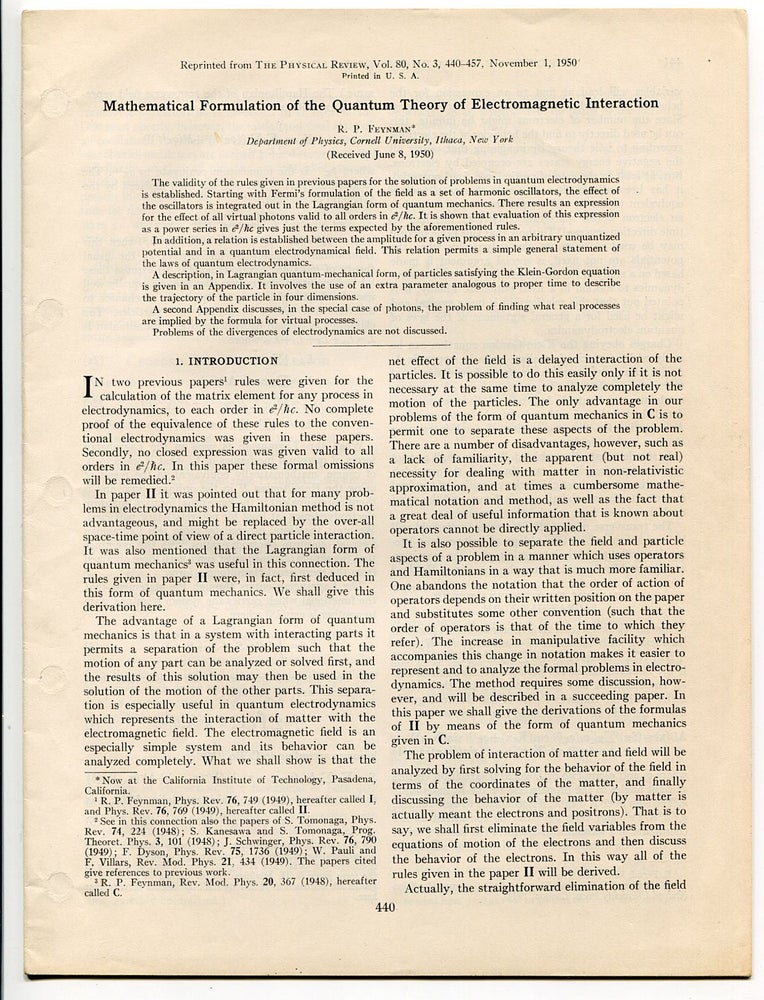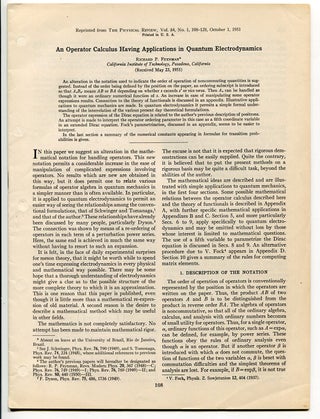Mathematical Formulation of the Quantum Theory of Electromagnetic Interaction. WITH: An Operator Calculus Having Applications in Quantum Electrodynamics
EXTREMELY RARE OFFPRINTS OF FEYNMAN’S FINAL TWO PAPERS ON QUANTUM ELECTRODYNAMICS, DESCRIBING THE MATHEMATICAL FOUNDATIONS FOR HIS PATH-INTEGRALS AND FEYNMAN DIAGRAMS.
Feynman himself stated about these papers: “In these two papers, I put everything that I had done and thought should be published on the subject [i.e., quantum electrodynamics]. And that was the end of my published work in this field” (quoted in Mehra, The Beat of a Different Drum, p. 325). We are not aware of any other offprints of any of Feynman’s papers on quantum electrodynamics having appeared on the market; no copies on OCLC.
“While Feynman made many original and imaginative contributions to theoretical physics, it may well be that his place in the history of science will be largely based on his approach to renormalizing quantum electrodynamics, and especially on the tools that he invented to accomplish that goal, such as path integrals, the operator calculus, and the famous Feynman diagrams” (Selected Papers, p. 7). “Nobody but Dick [Feynman] could use his theory, because he was always invoking his intuition to make up the rules of the game as he went along. Until the rules were codified and made mathematically precise, I could not call it a theory” (Freeman Dyson, quoted in David Kaiser, Pedagogy and the Practice of Science).
“In 1950-51 Richard Feynman wrote two papers in which he described the mathematical formulation of his method in quantum electrodynamics [the offered papers]… In the 1950 paper Feynman used the methods of his Ph.D. thesis and his 1948 paper in the Reviews of Modern Physics [“Space-Time Approach to Non-Relativistic Quantum Mechanics”] to derive the basic equations and principles of his method. In the second paper, Feynman gave further development of the formalism and discussed the new idea of how to proceed with non-commuting quantities… In these articles, besides deriving the old formulas, Feynman obtained new relations and derivations, and invented new approaches to solve different mathematical problems in quantum mechanics and quantum field theory…
“In [‘Mathematical formulation…’], Feynman established the validity of the rules given in previous papers for the solution of problems in quantum electrodynamics. Starting with Fermi’s formulation of the field as a set of harmonic oscillators, he integrated out the effect of the oscillators in the Lagrangian form of quantum mechanics. There resulted an expression for the effect of all virtual photons valid to all orders in e2/hc. Feynman showed that the evaluation of the expression as a power series in e2/hc gives just the terms expected by the aforementioned rules. In addition, Feynman established a relation between the amplitude for a given process in an arbitrary unquantized potential and in a quantum electrodynamical field. This relation permitted a simple general statement of the laws of quantum electrodynamics” (Mehra, pp. 301-2).
“Feynman’s 1951 article [‘An operator calculus’] was extremely rich in new mathematical ideas and inventions which he proposed to use in quantum theory, especially in quantum electrodynamics… The main new mathematical idea in this article was the introduction and development of the new operator algebra which originated from Feynman’s Ph.D. thesis and his 1948 paper in the Reviews of Modern Physics” (Mehra, p. 307). “In 1951, Feynman completed his work on quantum electrodynamics, describing and applying a new operator calculus for operators dependent on a continuous parameter (such as the time), which describes the ordering of application of the generally non-commuting operators. Using the ordering parameter, the ordinary methods of calculus (integration and power series expansions, for example) can be carried through without regard to the ordering until the final result, which is then appropriately reordered” (Selected Papers, p. 174). Feynman himself stated about this paper: “I felt it was important. In the years since I had invented it [quantum electrodynamics] I had accumulated a whole lot of debris. For instance, I had noticed certain ways of representing spin-0 particles with path integrals, I had the operator calculus, and a whole lot of other things which I did not know where to put. Most of it was, of course, the operator calculus, but in the various appendices I included a whole variety of other things. With this paper I disgorged myself of all the things I had thought about in the context of quantum electrodynamics; this was an entire backlog of valuable things. I still think that the central item, the operator calculus, is an important invention. With this paper I had completed the project on quantum electrodynamics. I didn’t have anything else that required publishing” (quoted in Mehra, p. 325).
Quantum electrodynamics is the quantum theory of the interactions between electrically charged particles and the electromagnetic field (between electrons, positrons and photons, for example). It has been called “the jewel of physics” because of the extreme accuracy of its predictions: for example, the value of the magnetic moment of the electron calculated from quantum electrodynamics agrees with the measured value to within a few parts in 100,000,000,000. Quantum electrodynamics was born in 1928, with Dirac’s paper “The quantum theory of the emission and absorption of radiation.” Although a major advance, this theory, and its development over the next decade by Fermi, Heisenberg, Jordan, Pauli and others, encountered serious difficulties: it predicted an infinite self-energy for the electron, and several other such “divergences” (analogous difficulties were already well known in classical electrodynamics). The solution to these problems was provided independently by Feynman, Julian Schwinger and Sin-Itiro Tomonaga, who shared the 1965 Nobel Prize in physics “for their fundamental work in quantum electrodynamics, with deep-ploughing consequences for the physics of elementary particles.”
These offprints derive from the estate of an officer of the Press Office of the Physics Department at Caltech.
Lancaster: American Physical Society, 1950;1951. Quarto (267 x 200 mm), two separate offprints from The Physical Review, Second Series, Volume 80, Number 3, pp. 440-457, November 1, 1950; Vol. 84, no. 1, pp. 108-128, October 1, 1951. Self-wrappers, stapled as issued (punch holes in inner margin filled, not affecting text). Very slight toning to edges of blank rear wrapper of “Mathematical Formulation”; otherwise fine. VERY SCARCE.
Price: $18,500 .



